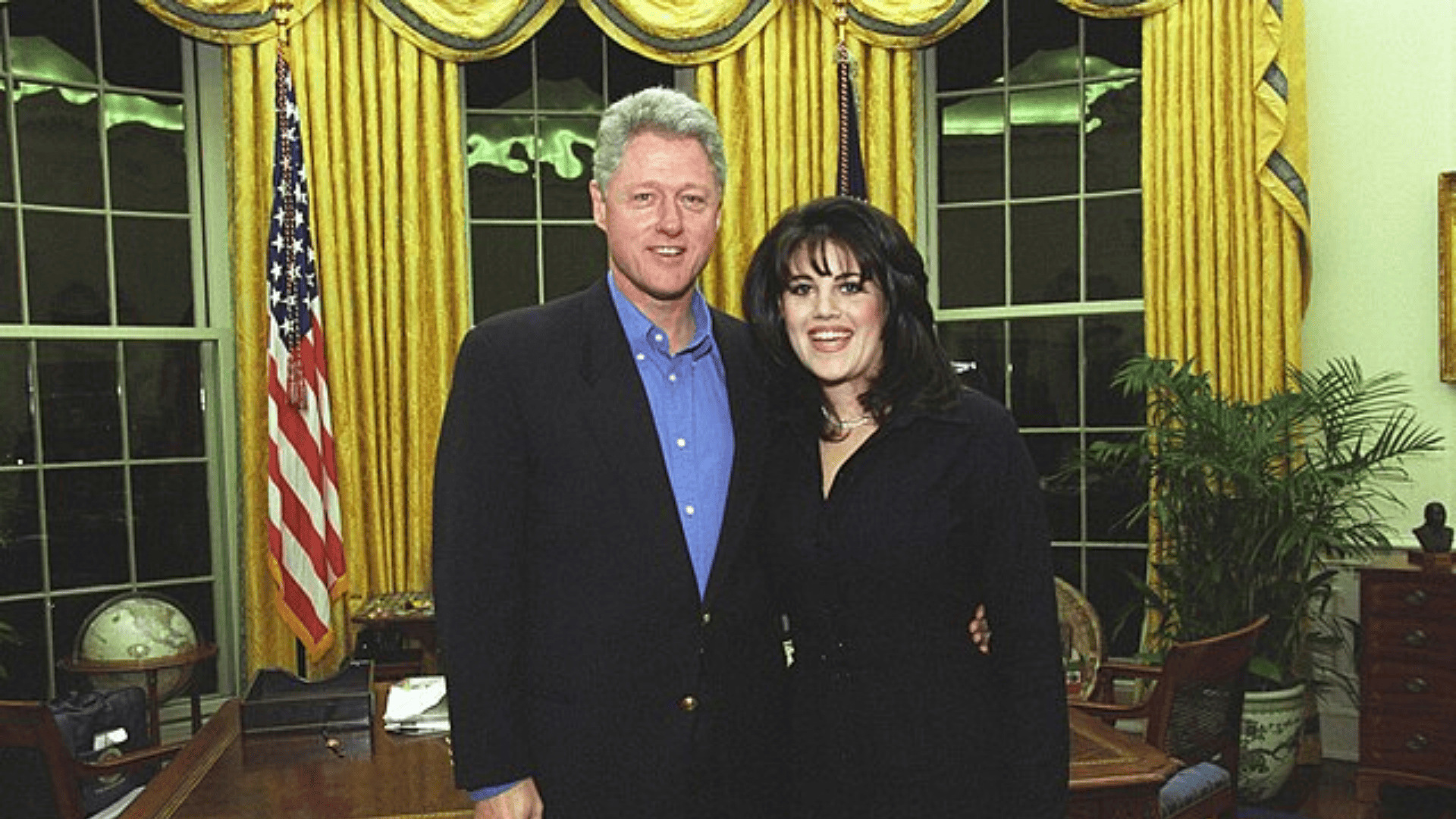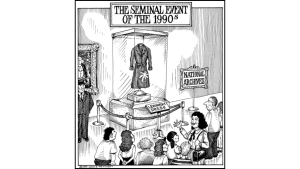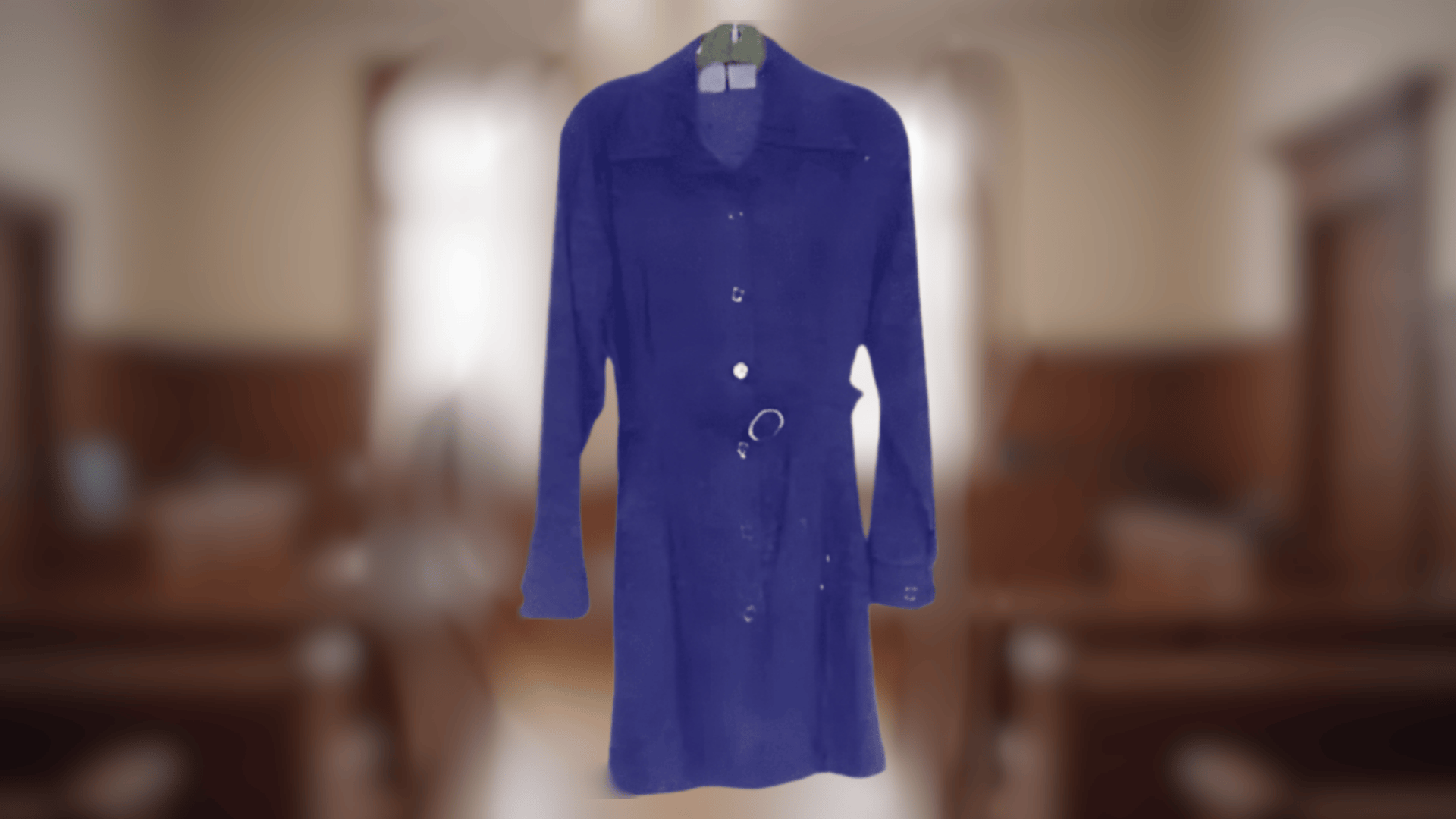In 1998, a navy blue Gap dress became one of the most famous pieces of evidence in American political history.
The Monica Lewinsky dress, with a stain that would be tested by the FBI, turned into key evidence in a scandal that led to President Bill Clinton’s impeachment.
Before this dress appeared, the situation was basically “he said, she said.” President Clinton denied having a relationship with White House intern Monica Lewinsky.
But when investigators tested the Monica Lewinsky dress stain and matched it to the president’s DNA, everything changed. What had been rumors suddenly became proven facts that no one could argue with.
The Relationship: What Investigators Found Out

According to the official investigation report called the Starr Report, named after Independent Counsel Kenneth Starr, Monica Lewinsky began working at the White House as an intern in 1995 when she was 21 years old.
President Clinton was 49. The report documented that the two had multiple encounters over about two years, from 1995 to 1996.
Why did these personal details matter legally? Because President Clinton had been asked direct questions about his relationship with Lewinsky during a deposition, that’s when someone answers questions under oath as part of a legal case.
He denied having “sexual relations” with her. If he lied while under oath, that’s a crime called perjury.
The investigation also looked into whether the president tried to hide evidence or convince others to lie.
These actions could count as obstruction of justice, another serious crime. So what started as questions about personal behavior became questions about whether the president had broken the law.
The Blue Dress: How It Became Evidence
The Monica Lewinsky dress might have stayed in a closet forever if not for a complicated chain of events.
Lewinsky had kept the dress without cleaning it after one of her encounters with the president. Her friend Linda Tripp advised her not to dry-clean it.
When Lewinsky made an immunity deal with investigators, meaning she agreed to tell the truth in exchange for protection from certain charges, she handed over the dress to the FBI in late July 1998.
Scientists at the FBI laboratory tested the Monica Lewinsky dress stain using DNA analysis. Think of DNA like a unique fingerprint that’s different for every person.
The FBI then compared the DNA from the dress to a blood sample that President Clinton provided. The results showed they matched.
The media initially reported confusing and sometimes incorrect information about the dress.
But once the FBI confirmed their findings in August 1998, the facts became clear.
Linda Tripp’s Role: Secret Recordings That Started Everything
Linda Tripp was a White House employee who became friends with Monica Lewinsky. Tripp secretly recorded her phone conversations with Lewinsky, in which Lewinsky talked openly about her relationship with President Clinton.
Tripp then gave these tapes to Independent Counsel Kenneth Starr, who was already investigating other matters related to the Clintons.
The tapes expanded the investigation to include questions about whether the president had lied under oath and tried to cover up the relationship.
Tripp also gave Lewinsky specific advice: don’t dry-clean the blue dress. Some people believe Tripp knew the dress might become important evidence someday. By keeping it uncleaned, the DNA evidence stayed intact.
Tripp’s actions divided public opinion. Some saw her as revealing the truth. Others viewed her as a betrayer who secretly recorded a friend’s private conversations. Either way, without Linda Tripp’s recordings and advice, the Monica Lewinsky dress might never have become evidence.
The Paula Jones Lawsuit: How a Civil Case Led to Impeachment

President Clinton was being asked questions under oath about his personal life because of a lawsuit filed by Paula Jones.
Jones was a former Arkansas state employee who sued President Clinton in 1994, claiming he had sexually harassed her years earlier when he was governor of Arkansas.
On January 17, 1998, President Clinton had to give a deposition for the Jones lawsuit. Lawyers asked him questions under oath, including questions about Monica Lewinsky.
He denied having a sexual relationship with her. These denials would later become the basis for perjury charges.
The legal case called Clinton v. Jones went all the way to the Supreme Court, which ruled that a sitting president could be sued in civil court for actions before taking office.
This decision meant Clinton had to answer questions in the Jones case.
Later, a judge found President Clinton in civil contempt, essentially saying he had given false testimony in the Jones case.
This finding, combined with the evidence from the Monica Lewinsky dress, gave Independent Counsel Starr material for his impeachment referral to Congress.
The Starr Report: 11 Possible Reasons for Impeachment
On September 9, 1998, Kenneth Starr sent a massive 445-page report to Congress. This document outlined 11 possible grounds for impeaching President Clinton, organized into four main categories:
- Perjury: The report claimed Clinton made false statements during his Jones case deposition on January 17, 1998, and later to a grand jury in August 1998. It also said he made misleading statements to White House aides who would likely become witnesses, knowing they might repeat his false version of events.
- Obstruction of justice: The report accused Clinton of encouraging Monica Lewinsky to file a false affidavit (a written statement under oath), helping hide gifts that had been subpoenaed (officially requested by investigators), and coaching potential witnesses about what to say.
- Witness tampering: This involved conversations with people who might testify, possibly designed to influence or shape what they would say in court.
- Abuse of power: The report argued that the president’s conduct went against his constitutional duty to faithfully execute the laws; essentially saying a president shouldn’t break the laws he’s supposed to enforce.
The Starr Report included extremely detailed and personal information about the Clinton-Lewinsky relationship. Many people felt this level of detail was unnecessary and embarrassing. Others argued that the details were needed to prove the legal case.
Impeachment and Trial: What Actually Happened
After receiving the Starr Report, the House of Representatives voted on December 19, 1998, to impeach President Clinton. “Impeachment” doesn’t mean removal from office.
It’s more like a formal accusation. The House approved two articles of impeachment:
- Perjury to a grand jury (approved 228-206)
- Obstruction of justice (approved 221-212)
Two other proposed articles failed to pass. The votes were mostly along party lines, meaning Republicans generally voted yes and Democrats generally voted no.
Next came the Senate trial, which lasted from January to early February 1999. The Constitution requires a two-thirds vote, 67 senators, to convict and remove a president.
The results fell far short:
- On the perjury charge: 45 guilty, 55 not guilty
- On the obstruction charge: 50 guilty, 50 not guilty
President Clinton was acquitted on February 12, 1999, meaning he stayed in office and completed his term.
However, “acquitted” didn’t mean “no consequences.” Later, through a separate process, Clinton had his Arkansas law license suspended for five years.
He also agreed to pay a fine and accept a five-year suspension from practicing before the U.S. Supreme Court. So while he wasn’t removed from office, he did face professional penalties.
The Perjury Question: What Words Mean
One of the strangest parts of this scandal involved arguing over the definition of words. During his grand jury testimony in August 1998, President Clinton famously said, “It depends on what the meaning of the word ‘is’ is.”
This wasn’t just silly wordplay. In the Paula Jones deposition, lawyers had provided a specific legal definition of “sexual relations.” President Clinton and his attorneys argued that under that particular definition, what happened with Monica Lewinsky might not technically qualify.
Critics called this ridiculous hair-splitting and dishonest evasion.
When DNA evidence from the Monica Lewinsky dress stain proved the relationship had occurred, these word-definition arguments seemed less important.
In January 1998, Clinton had also famously wagged his finger at TV cameras and said firmly, “I did not have sexual relations with that woman, Miss Lewinsky.”
This public denial, combined with his deposition testimony, made the later DNA evidence particularly damaging to his credibility.
The Dress as a Media Symbol

The Monica Lewinsky blue dress quickly became more than evidence; it became a cultural symbol. News anchors, late-night comedians, and newspaper columnists all referenced “the blue dress” as shorthand for proof of the scandal.
A study by the Pew Research Center found that news coverage of the scandal dominated American media in 1998.
The dress appeared in countless news stories, often representing the moment when rumors became facts. It symbolized how physical evidence could prove what people wanted to deny.
In pop culture, the dress appeared in jokes, sketches, and political cartoons.
Even decades later, people still refer to a “blue dress moment” to mean when undeniable evidence appears in any controversy. The image became so iconic that many people who weren’t even alive in 1998 have heard of the Monica Lewinsky dress.
Timeline: How Events Unfolded
|
1995-96: Monica Lewinsky works at the White House; her relationship with President Clinton begins and continues. January 17, 1998: President Clinton gives his deposition in the Paula Jones lawsuit and denies having sexual relations with Lewinsky. Late July-August 1998: Lewinsky turns over the dress to investigators as part of her immunity agreement; FBI tests confirm DNA match; Clinton testifies before the grand jury. September 9, 1998: Kenneth Starr sends his 445-page referral to Congress, recommending possible impeachment. December 19, 1998: The House of Representatives votes to impeach President Clinton on two charges. January-February 1999: Senate trial takes place. February 12, 1999: Clinton is acquitted on both charges. |
From start to finish, the public phase of the scandal lasted about 13 months, though the relationship itself had occurred years earlier.
How This Changed American Politics
The Clinton-Lewinsky scandal and the role of the Monica Lewinsky dress had lasting effects on American politics that we still see today.
- Independent counsel investigations: Congress let the independent counsel law expire in 1999 because many felt it gave prosecutors too much power to investigate endlessly without clear limits.
- Political polarization: The mostly party-line impeachment votes deepened divisions between Republicans and Democrats, with very few members breaking ranks. Many historians point to this as an early example of the intense political polarization that characterizes American politics today.
- Personal privacy vs. public interest: People disagreed about where to draw the line between personal behavior and fitness for office. This debate continues whenever public officials face scandals.
- Presidential accountability: The House established that perjury and obstruction in a civil case could be impeachable offenses, but the Senate’s acquittal suggested these didn’t warrant removal.
- The independent counsel law: The Starr investigation lasted years and cost tens of millions of dollars, leading both parties to let the law expire. Today, special counsels operate under different rules with more oversight from the Justice Department.
Why This Story Still Matters
The Monica Lewinsky dress represents a unique moment when physical evidence transformed political controversy into legal proceedings.
The DNA match between the Monica Lewinsky dress stain and President Clinton’s sample turned denials into proven facts.
For Monica Lewinsky herself, the scandal had devastating personal effects. She faced intense harassment, public shame, and difficulty finding work.
The blue dress remains one of the most recognizable pieces of evidence in modern American history.
Understanding this scandal helps us think about important questions that remain relevant today: What standards should we hold our leaders to? When does private behavior become a public matter? How should investigations be conducted? These questions continue to shape American political debates.
Sources
- Transcripts of Linda Tripp’s secret recordingswith Monica Lewinskywere submitted as evidence during the impeachment inquiry.
- The Clinton v. Jones legal case documents, including the 1997 Supreme Court ruling, provided the legal basis for Clinton’s deposition under oath in the Paula Jones lawsuit.
- The Starr Reportis the formal, detailed summary submitted to Congress by Independent Counsel Kenneth Starr in September 1998.







